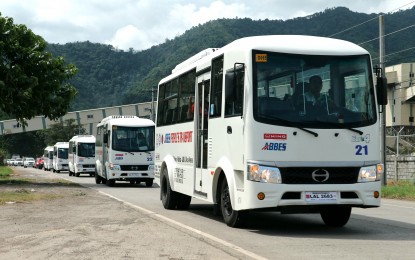
MODERN RIDE. Modern jeepneys in Malita, Davao Occidental plying the Davao City-Jose Abad Santos and vice versa route. An estimated 76 percent of all active public utility vehicles are now operated by cooperatives and corporations or are owned by operators who have applied for consolidation before the Dec. 31 deadline. (PNA photo by Robinson Niñal Jr.)
MANILA – An estimated 76 percent of all active public utility vehicles (PUVs) are now operated by cooperatives and corporations or are owned by operators who have applied for consolidation before the Dec. 31 deadline.
In a press conference at the Land Transportation Franchising and Regulatory Board (LTFRB) headquarters in Quezon City on Friday, LTFRB Board Member Riza Paches said 145,721 PUVs, or 76 percent of all PUVs operating in fixed routes nationwide, are consolidated or have applied for consolidation.
Specifically, Paches said the consolidation rate for public utility jeepneys (PUJs) has reached 73.9 percent while UV Express (UVE) units have reached 82 percent.
She noted that the National Capital Region (NCR) has reported the highest number of last-minute consolidation applications, with 97 percent of registered PUVs having complied with the consolidation requirement.
“Tayo po ay 21,655 (consolidated) because there are only 22,284 confirmed units for PUJs and for the UVEs, nasa 100 percent almost 'yung consolidation when we try to look at the figures of confirmed units (We have 21,655 consolidated PUJs out of 22,284 confirmed units, and for UVEs we have almost 100 percent consolidation compared to confirmed units),” Paches said.
These confirmed units, she added, are PUVs that have valid franchises or other necessary documentary requirements.
She noted that the consolidation applications received by the LTFRB exceeded their projections.
“Overall, we projected around 18,026. But after Dec. 31, those who consolidated and applied for consolidation were 25,629 units. This makes up 142 percent of what we projected,” Paches said.
She said the consolidation campaign was “successful,” especially during the last stretch of December last year.
“The government agencies that have been opening up their offices, relaxing certain policies and requirements, and even reaching out to all these transport operators, was to the LTFRB's perspective, effective in trying to reach more than what we expected,” Paches said.
In the same presser, LTFRB chair Teofilo Guadiz III said while some unconsolidated PUVs would be allowed to operate until Jan. 31, they would not be allowed to register with the Land Transportation Office (LTO) beyond that date without joining a transport cooperative or company.
“Meron requirement na confirmation ang LTFRB na ibibigay sa LTO para 'yun po 'yung basis ng LTO na ire-register kita na PUV. Pero kung hindi kayo nag-consolidate, hindi na kayo bibigyan ng confirmation so hindi ka na rin po mare-rehistro as PUV (The LTFRB provides a confirmation to the LTO, which they would use as the basis for their registration as PUV. But if they’re not consolidated, they will not be given confirmation so they won’t be able to register),” Guadiz said.
However, Office of Transportation Cooperatives chair Andy Ortega assured PUV operators and drivers affected by the consolidation drive that the government would provide them with due process.
He encouraged drivers who worked for operators who failed to consolidate, to join transportation cooperatives and companies to continue working as PUV drivers. (PNA)
